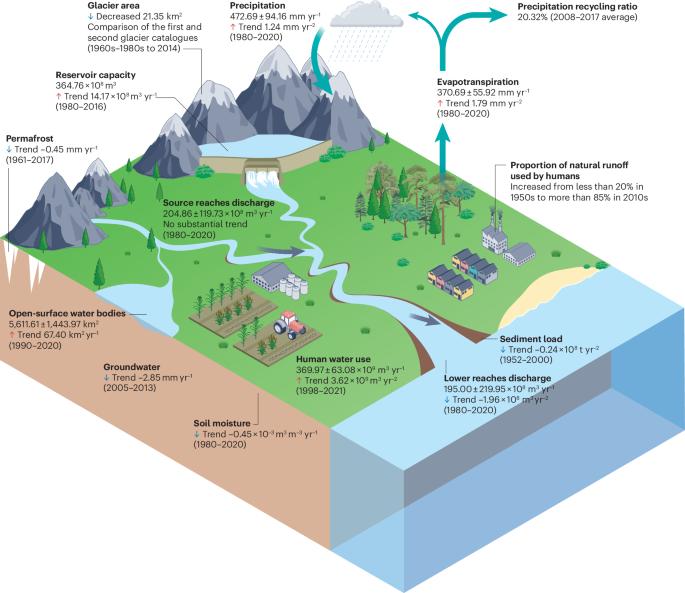Anthropogenic impacts on the Yellow River Basin
引用次数: 0
Abstract
The Yellow River Basin supports a population of 200 million people and contains 15% of arable land in China. Water scarcity in the region is being exacerbated by climate change and human activities. In this Review, we discuss anthropogenic impacts on the hydrological cycle and sediment dynamics of the Yellow River since the 1950s. The Yellow River had one of the largest sediment loads in the world, peaking at 2.1 Gt yr−1 in 1958. Such high sediment loads elevated flood risk; therefore, reservoirs, conservation and revegetation projects were implemented, reducing sediment transport by 90% since the 1980s. However, these efforts also impacted the hydrology of the Yellow River Basin, leading to an increase in evapotranspiration fluxes (1.79 mm yr−2, 1980–2020) and reduced runoff. In addition, human water use has increased by 15.8% since the 1980s. The resulting reductions in soil water storage and intensification of the vertical water cycle foreshadow potential resource crises and will potentially lead to irreversible ecosystem degradation. Predicting the outcomes of water management policies and engineering projects is essential but highly complex owing to feedback loops and interactions between human activities and hydrological changes. Addressing these challenges, which are also faced by other arid-region rivers, will require dynamic monitoring of water storage and improved understanding of human–hydrological interactions. Anthropogenic pressures threaten water sustainability and ecological integrity in the Yellow River Basin. This Review outlines changes in water cycling and sediment loads in the region since the 1950s and discusses the impacts of demographic shifts, patterns of water use, land use transformations and socioeconomic development.

黄河流域的人为影响
黄河流域供养着2亿人口,拥有中国15%的可耕地。气候变化和人类活动加剧了该地区的水资源短缺。本文讨论了20世纪50年代以来人类活动对黄河水循环和泥沙动态的影响。黄河是世界上含沙量最大的河流之一,1958年达到峰值2.1亿吨/年。如此高的泥沙负荷增加了洪水风险;因此,实施了水库、涵养和植被恢复工程,自20世纪80年代以来,输沙量减少了90%。然而,这些努力也影响了黄河流域的水文,导致蒸散发通量增加(1.79 mm yr - 2, 1980-2020)和径流减少。此外,自20世纪80年代以来,人类用水增加了15.8%。由此导致的土壤储水量减少和垂直水循环的加剧预示着潜在的资源危机,并可能导致不可逆转的生态系统退化。预测水管理政策和工程项目的结果至关重要,但由于人类活动和水文变化之间的反馈循环和相互作用,预测结果非常复杂。要解决其他干旱地区河流也面临的这些挑战,需要对储水量进行动态监测,并提高对人类与水文相互作用的理解。人为压力威胁着黄河流域水资源的可持续性和生态完整性。本文概述了20世纪50年代以来该地区水循环和泥沙负荷的变化,并讨论了人口变化、水利用模式、土地利用转变和社会经济发展的影响。
本文章由计算机程序翻译,如有差异,请以英文原文为准。
求助全文
约1分钟内获得全文
求助全文

 求助内容:
求助内容: 应助结果提醒方式:
应助结果提醒方式:


